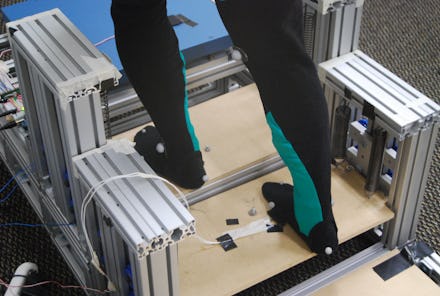This gadget helps you get up the stairs more easily with springs and magnets

As people age, stairs become a major reason why they choose to move or install expensive stairlifts or escalators, which can easily crack five-digit price tags per flight. And it turns out that the less often you navigate stairs, the worse you get at it.
Karen Liu, a computer scientist at the Georgia Institute of Technology, worries stairs could become a real issue for her mother. “She’s probably the healthiest 70-year-old I know,” Liu said. “But she always complains about climbing stairs.”
So when Liu heard about an exoskeleton that stores energy to make walking easier, she wondered if there was a way to do the same thing for stairs. She wanted to design something inside the steps themselves, rather than a device someone would have to put on their body.
Liu enlisted two engineering colleagues (“I’m a computer scientist; I don’t know how to do anything in the real world,” she joked.) and set to work creating a prototype, which they describe in a paper published Wednesday in PLoS ONE.
They realized that while going up stairs takes a lot of energy throughout the process, going down stairs is pretty wasteful of energy — Liu called it “a sequence of stopping and falling, stopping and falling.”
So they designed a system of springs and magnetic locks that holds a movable stair tread. Walking down the stairs compresses the spring and lowers the tread, storing energy; climbing up the stairs releases that spring, lifting the tread and your body. Lena Ting, an engineer on the project, compared the system to stretching a rubber band with the user’s weight.
Even as a prototype, the system can be installed on top of existing stairs. That means they can even be used for a short period of time, like while someone is recovering from a surgery. Right now, the cost of the system works out to about $50 per step.
So far, the team is mostly focused on individual users in a private setting, where an even split between trips up and down a flight of stairs is realistic. But they do think the system could be adjusted for staircases serving multiple people, where, say, three people could go downstairs before one comes up.
They also still need to test the system with their main target user: older people. “This was just a proof of principle for whether it’s possible to gain some benefits from spring-loaded stairs,” Ting said.
But the graduate students they used as guinea pigs for this initial work felt the lift. “They felt that it was kind of fun, funny, interesting, different to use it,” Yun Seong Song, the paper’s lead author, said. “Coming down our stairs felt like they were coming down a hill with very cushiony grass.”
The device has its dangers, though — it may spoil you for stairs forever. After the graduate students tested the springs, the team locked the treads in place and had them climb like normal again. “Some of them responded they didn’t know that going up and down the stairs was so difficult,” Song said.